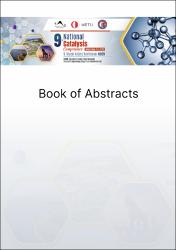| dc.contributor.author | Kurtoğlu-Öztulum, Samira Fatma | |
| dc.contributor.author | Yalçın, Kaan | |
| dc.contributor.author | Zhao, Yuxin | |
| dc.contributor.author | Ünal, Uğur | |
| dc.contributor.author | Uzun, Alper | |
| dc.date.accessioned | 2024-03-21T06:15:48Z | |
| dc.date.available | 2024-03-21T06:15:48Z | |
| dc.date.issued | 2023 | en_US |
| dc.identifier.citation | Kurtoğlu-Öztulum, Samira F., Yalçın, K., Zhao, Y., Ünal, U., Uzun, A. (2023). Reduced graphene aerogel-supported Ir(C2H4)2 complexes at an exceptional Ir loading of 23.8 wt%: Confirming site-isolation by combining XAS and STEM. 9th National Catalysis Conference, 24. | en_US |
| dc.identifier.uri | https://hdl.handle.net/20.500.12846/892 | |
| dc.description.abstract | Atomically dispersed supported metal catalysts offer significant opportunities when compared to
conventional analogues. They provide maximum utilization of expensive noble metals, interesting
catalytic properties, and understanding of structure-catalytic activity relationships [1]. These novel
catalysts consist of supported single metal atoms bonded to ligands as well as clusters incorporating
only a few metal atoms. However, they face certain challenges hindering their industrial use. The main
challenges are their limited stability and limited metal loading. Typical metal loadings are limited with
<1 wt.%. The support material is crucial in overcoming these challenges. Here, we used reduced
graphene aerogel (rGA) as a novel support for Ir(C2H4)2 complexes and assessed the maximum metal
loading we can reach. Thanks to the outstanding properties of rGA, such as excellent electronic
properties, high porosity and surface area, and multiple bonding sites for Ir atoms, an exceptionally high
Ir loading of 23.8 wt% was obtained. Aberration-corrected scanning transmission electron microscopy
(STEM) images and X-ray absorption spectroscopy (XAS) data confirmed the site-isolation of Ir atoms
at this exceptional loading. Figure 1 shows the STEM images of rGA-supported Ir(C2H4)2 complexes
at an Ir loading of 23.8 wt%, a challenging sample because of the three-dimensional multilayer
wrinkled-sheet structure of rGA. Besides, these images are one of the first atomic resolution images
obtained on a Hitachi HF5000 Cs-corrected cold FEG STEM in Koç University. Results demonstrate
the potential of rGA as a superior support material for expensive noble metal complexes to reach
exceptional loadings. | en_US |
| dc.language.iso | eng | en_US |
| dc.publisher | Turkish Catalysis Society | en_US |
| dc.rights | info:eu-repo/semantics/openAccess | en_US |
| dc.subject | Atomic dispersion, | en_US |
| dc.subject | X-ray absorption | en_US |
| dc.subject | Graphene aerogel | en_US |
| dc.subject | Supported metal complexes | en_US |
| dc.subject | STEM | en_US |
| dc.title | Reduced graphene aerogel-supported Ir(C2H4)2 complexes at an exceptional Ir loading of 23.8 wt%: Confirming site-isolation by combining XAS and STEM | en_US |
| dc.type | conferenceObject | en_US |
| dc.relation.journal | 9th National Catalysis Conference | en_US |
| dc.contributor.authorID | 0000-0001-9136-6988 | en_US |
| dc.relation.publicationcategory | Konferans Öğesi - Uluslararası - Kurum Öğretim Elemanı | en_US |
| dc.contributor.department | TAÜ, Fen Fakültesi, Malzeme Bilimi ve Teknolojileri Bölümü | en_US |
| dc.identifier.startpage | 24 | en_US |
| dc.identifier.endpage | 24 | en_US |

















